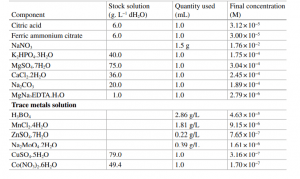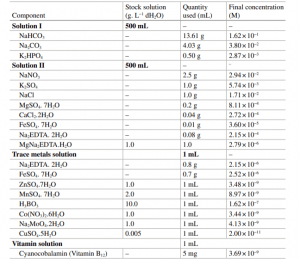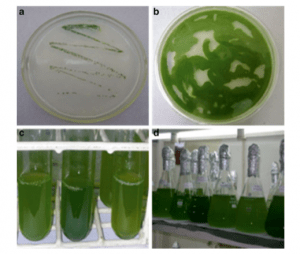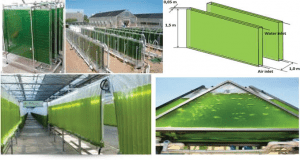ALGAE CULTURING TECHNIQUES
Introduction
- For algae culturing techniques, the artificial algae culture medium is supplemented with various chemicals so that it resembles the natural environment.
- For the initiation of the aquaculture process, the isolation of the axenic culture of algae is the first step.
- Axenic culture should be preserved for a longer period of time.
- The algal reservoir should be free of various contaminants and bacteria.
- Algal culture media are divided into two broad classes viz Freshwater culture media and marine culture media.
- Samples that are collected for algae culturing techniques are not pure.
- Below are the algae culturing techniques.

STERILIZATION
- Sterilization is usually done to develop an aseptic culture environment by killing the microorganisms.
- Autoclaving (heat sterilization) is commonly practiced for algal cultures.
- Some precautions should be taken before culturing algae
- Laminar flow should be turned on before starting the culture work.
- The working surface should be cleaned with 70 % ethanol.
- The Bunsen burner should be used.
- After organizing all requirements under the laminar flow, hands should be cleaned with 70 % ethanol.
- All the sterile pipette, loop, or any material which are going to be used in culture should be flamed and it should be cooled before used.
- All the rim of the test tubes, Petri plates should be flamed and cooled down before use.
- The loop or pipette should be cleaned after every use.
PREPARATION OF STOCK SOLUTIONS
- Algae culture medium is generally composed of three components macronutrients, trace elements and vitamins. They are termed as stock solutions.
- Concentrated stock solutions for these components are prepared and then subsequently diluted to the final media concentration.
- Stock solutions are generally prepared in quantities of 100 mL to 1 liter.
- The sock solutions are stored at 4 °C in a tightly sealed glass bottle so that the final concentration of the solution does not change.
TYPES OF ALGAE CULTURE MEDIUM
- Bold Basal Medium – Used for culturing fresh algae.
- Prepared using the macronutrients, EDTA, Iron, Boron and Trace Metal Solution.
- The pH of 6.5 is maintained in the algae culture medium for optimal growth.


- Chu 10 medium – Used for the culture of various algae such as green algae, diatoms and cyanobacteria.
- It is an antificial medium.
- No chelators, vitamins and trace metals are added.
- The pH of the culture is maintained at 6.5.

- Medium for diatoms – Mainly for the culture of various diatom species
- Soil extract is used for this medium.
- All the components are dissolved in 900 mL of dH2O except vitamins.
- The final volume is brought up to 1 liter using dH2
- Then it is sterilized.
- Vitamins are added after cooling the stock solution.
- Then the pH is adjusted to 6.7.
- The vitamin solution is prepared by adding thiamine HCl into 950 mL of dH2
- 1 mL each from all the stock solution is used and is brought to 1 liter.
- The solution is then frozen for storage.

- Medium for volvox culturing – Mainly used for the culture of Volvox species.
- Also used for the culture of some strains of Eudorina, Pandorina and Gonium.
- Calcium nitrate and glycylglycine are dissolved in 900 mL of dH2O followed by other stock solutions.
- Then vitamins are added.

- Medium for blue-green algae (BG11) – Mainly for the culture of Cyanobacteria.
- Used for freshwater, soil and marine organisms which do not require high ionic strength.
- pH of the culture was maintained at 7.5 for optimal growth.
- Then it is autoclaved.

- Medium for Spirulina – Mainly for Spirulina
- Two separate solutions are prepared.
- Then autoclaved separately.
- The two solutions are combined aseptically and after that 1 mL of cyanocobalamin (B12 ) is added.

ISOLATION OF ALGAL SAMPLES
- Beijerinck first started the techniques for the isolation of microalgae.
- Water samples are collected in clean bottles and kept at a lower temperature so that the cells remain viable.
- Many techniques such as filtration, differential centrifugation, micro pipetting, serial dilution, etc are used for isolation and purification of the algal samples.
ANTIBIOTIC TREATMENT
- Antibiotic treatment is sometimes necessary to obtain pure unialgal cells.
- Penicillin, streptomycin and gentamycin are the common antibiotics used in the microalgal culture.
- The principle of this treatment is, it diminishes the bacterial growth without affecting the algal growth.
- A range of 50–500 mg/l concentrations of antibiotics is generally used.
- The antibiotics prepared for the use in the algal culture are preserved in frozen condition until use.

MODERN MICROALGAL ISOLATION METHOD
- Automated isolation method for microalgae has been developed.
- Flow cytometry is used in the automatic isolation method.
- The main principle in Flow cytometry is scattering of light, excitation and emission of fluorochrome molecules to generate specific multi-parameter data from particles and cells.
- The light source used in flow cytometry is mainly lasers.
- Lasers have a very small size hole to focus light.
- Hence, large single cells are excited thereby reducing the chance of more than one cell.

OPEN POND SYSTEM FOR ALGAE CULTIVATION
- Open ponds are of two types namely natural lakes, lagoons or ponds and artificial systems.
- The major benefit of an open system is that they are easy to handle than the other systems.
- At the same time mixing the culture is very difficult in open systems thereby producing less biomass.

CLOSED CULTURE SYSTEM
- This is carried out by using photobioreactors.
- Photobioreactors are of various types such as a tubular, flat panel or column reactors.
- They used external light supplies for their growth.
- Tubular photobioreactors for algal cultures – long, transparent tubes which can be horizontal vertical or as a helix
- Airlifts create the pumping force which allows CO 2 and O 2 to be exchanged between the liquid medium and the aeration gas.

- Flat Panel Photobioreactors – the algal culture is mixed across the flat panel system.
- Algae which are above the culture absorbs the light.
- Good for immobilization of algae.
- It provides high photosynthetic efficiencies.

- Column Photobioreactors – They are in vertical position or can be bubbled from below.
- The light passes through the culture from the transparent walls.
- These bioreactors give a good mixing of the culture.
- They provide a very high rate of gas transfer.

MACROALGAE CULTIVATION
- marine algae are macroscopic
- Also called seaweeds.
- They include green, brown and red algae.
- Seaweeds are brought to the laboratory after collecting form field.
- The epiphytes and epifauna are removed manually.
- Vegetative tissue or spores are used for maintaining the culture of seaweeds.
- For large scale cultivation, the macroalgae are usually cultured in natural seawater.
- Nutrients and other trace metals are supplied for laboratory culture for growth.
- Macroalgae are cultured in a sterilized glass or Petri dishes filled with enriched medium.
- They are covered with parafilm.
- Algae culture medium is changed depending on the material and temperature.
- The algal thalli are allowed to acclimatize for 4–5 days in sterilized seawater with desired salinity before starting the culture work.
- The thalli are weighed and are cut into small pieces of approximately 2–3 cm.
- After cutting the pieces are transferred to 500 mL of the cleaned conical flask containing 200 mL of sterilized liquid media.
- F/2 medium and PES medium are the most common culture media used.

DISINFECTANT TREATMENT OF ALAGL THALLI
- In order to make the culture free from contamination, the thalli are treated with various disinfectant series.
- The thalli are treated with a 1 % IKI solution for 1 min to eliminate surface microbes.
- The broad-spectrum antibiotic mixture is used for sterilization to prevent any kind of bacterial growth.
- Inside 300 mL of autoclaved seawater in a flask the thalli are cultured.
- 1 % of GeO2 (Germanium dioxide) is added for the prevention of diatoms growth.
